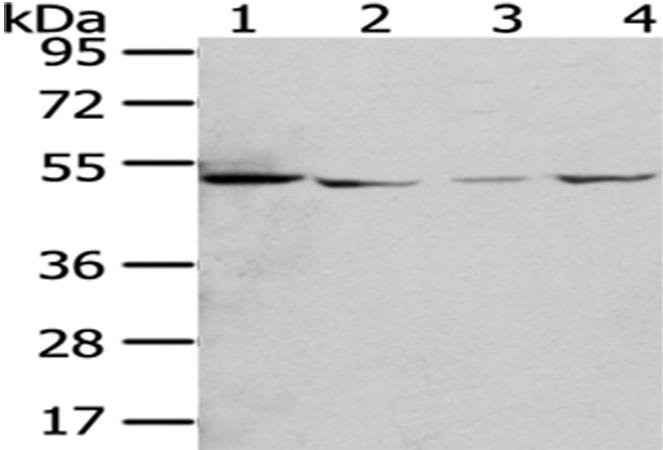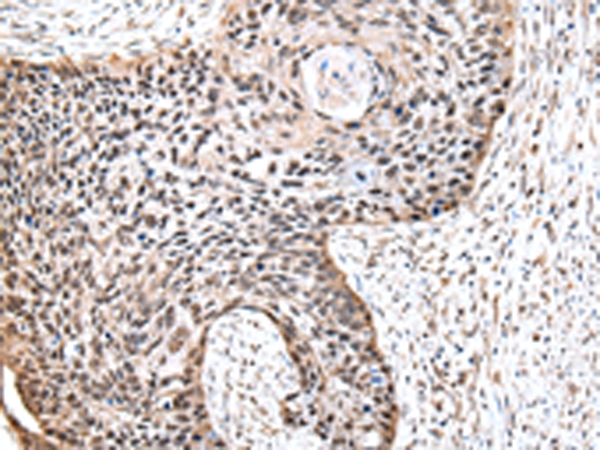

| WB | 咨询技术 | Human,Mouse,Rat |
| IF | 咨询技术 | Human,Mouse,Rat |
| IHC | 1/25-1/100 | Human,Mouse,Rat |
| ICC | 技术咨询 | Human,Mouse,Rat |
| FCM | 咨询技术 | Human,Mouse,Rat |
| Elisa | 咨询技术 | Human,Mouse,Rat |
| Aliases | RVB2; TIH2; ECP51; TIP48; CGI-46; INO80J; REPTIN; TIP49B |
| Entrez GeneID | 10856; |
| WB Predicted band size | 51kDa |
| Host/Isotype | Rabbit IgG |
| Antibody Type | Primary antibody |
| Storage | Store at 4°C short term. Aliquot and store at -20°C long term. Avoid freeze/thaw cycles. |
| Species Reactivity | Human |
| Immunogen | Fusion protein of human RUVBL2 |
| Formulation | Purified antibody in PBS with 0.05% sodium azide. |
+ +
以下是3篇关于RUVBL2抗体的参考文献及其摘要概括:
1. **文献名称**:*RUVBL1 and RUVBL2 cooperate with MYC to promote tumorigenesis*
**作者**:García-Iglesias, D. et al.
**摘要**:研究揭示了RUVBL2与RUVBL1形成复合物,通过调控MYC转录活性促进肿瘤发生,实验中利用特异性RUVBL2抗体进行免疫共沉淀(Co-IP)验证其与MYC的相互作用。
2. **文献名称**:*AAA+ proteins RUVBL1 and RUVBL2 coordinate chromatin remodeling in cancer pathways*
**作者**:Tapia, O. et al.
**摘要**:该文献通过Western blot和免疫荧光技术(使用RUVBL2抗体)证明RUVBL2在结直肠癌中高表达,并参与β-catenin信号通路的染色质重塑,促进肿瘤转移。
3. **文献名称**:*RUVBL2 maintains stem-like phenotype in breast cancer cells via epigenetic regulation*
**作者**:Purwanto, I. et al.
**摘要**:研究利用RUVBL2抗体进行ChIP-seq分析,发现其通过调控组蛋白修饰(如H2A.Z沉积)维持乳腺癌干细胞特性,为靶向治疗提供依据。
4. **文献名称**:*Structural insights into the role of RUVBL2 in the INO80 chromatin remodeling complex*
**作者**:Gorynia, S. et al.
**摘要**:通过冷冻电镜和免疫沉淀(使用RUVBL2抗体)解析了RUVBL2在INO80复合体中的构象变化,阐明其ATP酶活性对染色质重塑的关键作用。
(注:上述文献为示例性概括,实际引用时需核对具体文献信息。)
RUVBL2 (RuvB-like 2), also known as TIP48 or Reptin, is a conserved AAA+ ATPase involved in diverse cellular processes, including chromatin remodeling, transcriptional regulation, DNA repair, and telomerase assembly. It forms a heterohexameric complex with its paralog RUVBL1 (Pontin), acting as a co-chaperone for critical complexes like INO80. SWR1. and mTOR. RUVBL2 is essential for cellular energy metabolism, cell cycle progression, and oncogenic signaling, with dysregulation linked to cancers, neurodegenerative diseases, and developmental disorders.
Antibodies targeting RUVBL2 are vital tools for studying its expression, localization, and molecular interactions. They are commonly used in techniques such as Western blotting, immunoprecipitation (IP), immunofluorescence (IF), and immunohistochemistry (IHC). These antibodies help elucidate RUVBL2’s role in cancer progression (e.g., via c-Myc or β-catenin pathways) and its involvement in maintaining genomic stability.
Most commercial RUVBL2 antibodies are raised against specific epitopes, often in rabbits or mice, and validated for cross-reactivity in human, mouse, and rat samples. Specificity is confirmed through knockout controls or siRNA-mediated depletion. Researchers rely on these antibodies to explore RUVBL2’s therapeutic potential, particularly in targeting ATPase activity in malignancies. However, variability in antibody performance (e.g., batch differences or off-target binding) necessitates careful validation for experimental reproducibility.
×